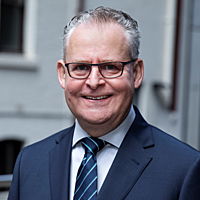Gross Mineral Product (GMP) as a tool for sizing the global critical minerals economy
Critical minerals are one of my favorite areas of the thematic investing space. There is a great story. You get to talk about the Periodic Table. There are weird names and the prospect of travel to exotic places.
You could wind up in the desert in Western Australia!
Seriously though, as most thematic investors appreciate, there are times when the tourists turn up in the financial markets.
The hype breaks all records, and the politicians are asking:
How can we secure our supply of Unobtanium free from the machinations of Aliens of Concern?
Um, yeah. Sometimes the world hits peak crazy, at least until the market slumps.
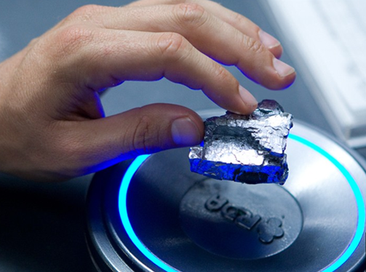
How the hell did we get here?
Thematic investors ask themselves this question all the time. There is a thing called the Hype Cycle, that starts out small, wiggles and wobbles a little, then grows huge, rolls over and dies, only to be reanimated as the... Next Hype Cycle!
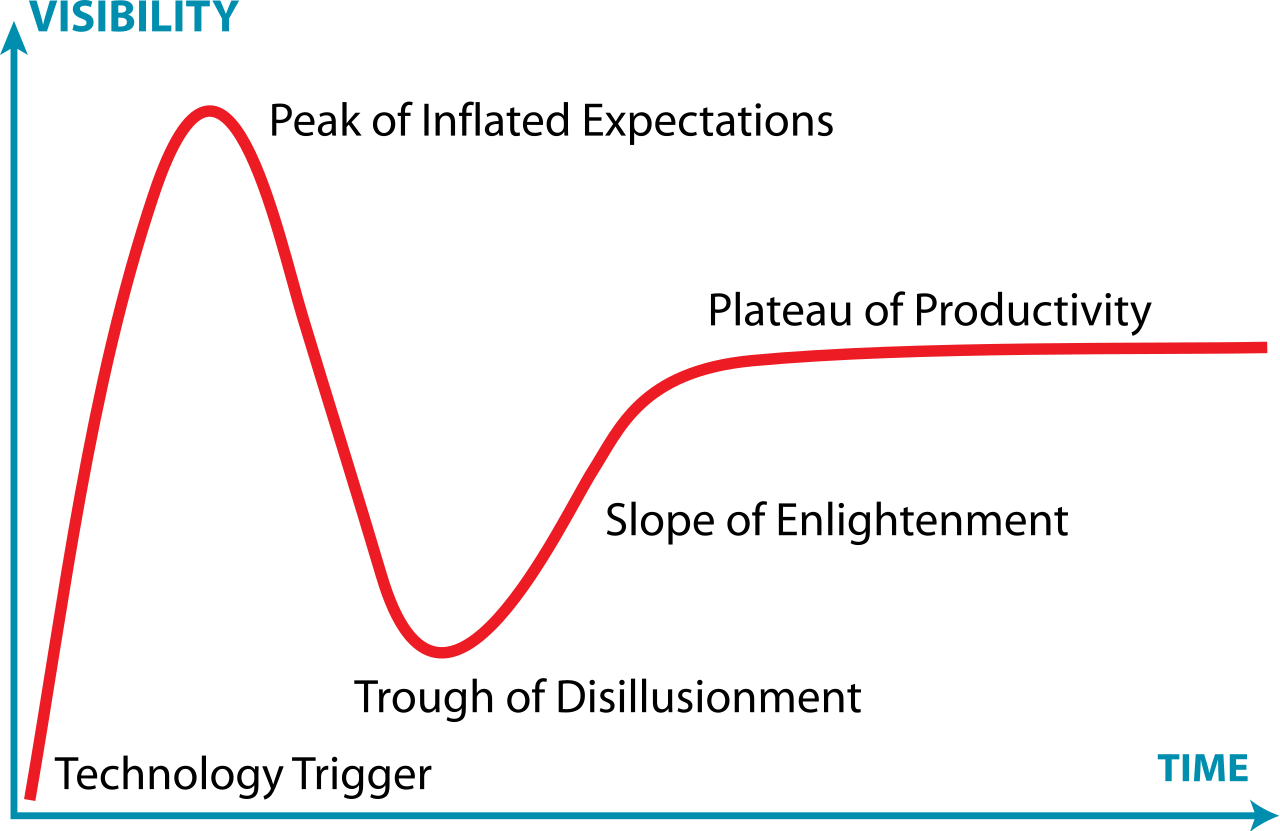
It is easy to scoff, and there is a similar version for resource investors called the Lassonde curve, named for Canadian mining entrepreneur Pierre Lassonde.
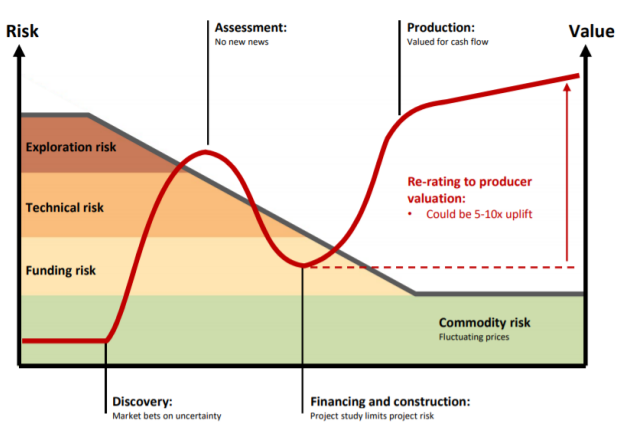
The so-called orphan period occurs after the final resource assessment, heading into the financing and construction phase. Lassonde first developed this for gold companies and explained it in his famous tome The Gold Book (1990).
There have been attempts to validate the concept, with some success. There are not hard and fast rules on timelines, or the strict event sequence. However, it is a useful concept. Within the critical minerals space, there are further complicating factors, like offtake deals. These are very important for mine financing, since you cannot sell the product into a liquid market, like the monetary metals, gold and silver, or even the base and precious metals, with hedging.
However, the key idea applies, mine projects go through successive stages of risk reduction, followed by value uplift as each stage of project risk is addressed, and (hopefully) overcome.
If you have a look at pretty much any rare earth chart today, you can see that we are now zooming down that part of the roller coaster labelled "The Orphan Period".
Throw your hands up and enjoy the ride!
Tough to state, but there you go. Oh, but look, it gets better later!
Definitely, it will for some projects, but not for all projects.
At times like this, I generally switch off the Eikon terminal, and go do research to get a better idea of how the underlying market trend is developing, in a demand sense.
For the critical minerals, this involves a huge effort, as there are so very many of them. One can easily go crazy, jumping from one exotic element to the next, wondering which really matter.
How to size the Critical Minerals Economy?
I am going to introduce readers to a very simple idea whose time has come. This idea was born of necessity, way back in 2010 when I last worked extensively on rare earth investments.
I even have a slide to prove it.

I got into critical minerals when I worked for a major Australian investment bank, here symbolized by an ever-loving tasty doughnut. That was back in 2010 when a Japanese investor group came to us asking for a Rare Metals Investment Strategy.
We asked ourselves a simple question:
What do the Japanese mean by "Rare Metals", is that Platinum Group Metals?
The answer, as we soon found out, was "No". The Japanese Ministry of Economy Trade, and Industry (METI), had an actual list of metals they called "The Rare Metals List". We looked up the list, thinking it would be rare earths, but it was more than that.
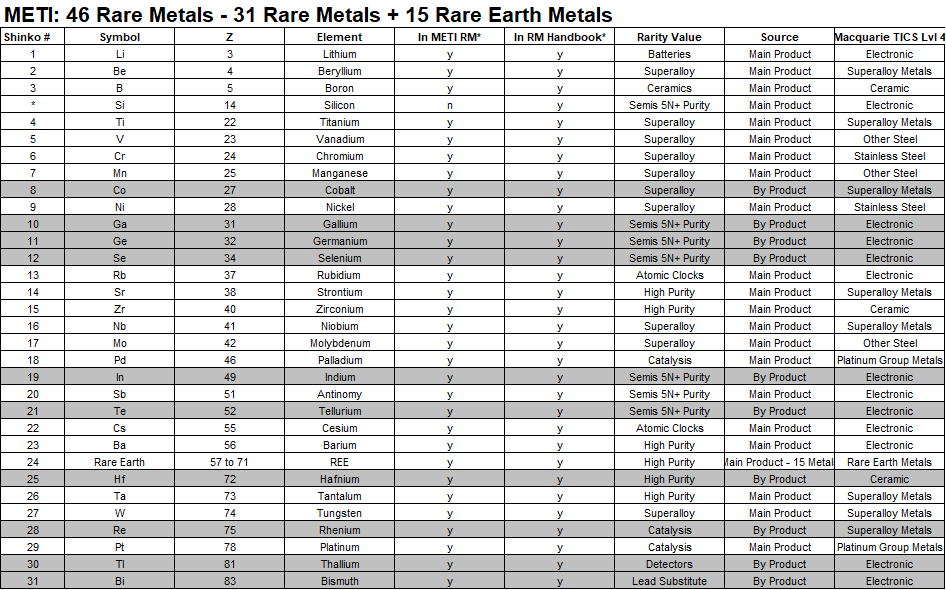
The above list was the basis of our investment strategy, as prepared for the Japanese. You can see the annotations in the table about production sources and typical uses. There is a table reference to the "Rare Metals Handbook", an industry classic reference from the 1950s.
I bought a copy from a second-hand book seller, the 1971 edition. It did the periodic table to death on all the advanced technology applications for rare metals. The first edition was an Atomic and Space Age work, literally. It was published 1954. The second edition added electronics and semiconductor applications, and first came out in 1961.
The good news is that the metals have not changed, only the politics.
However, I should be careful there. The Cuban Missile Crisis was 1962, so this book was current when the last Cold War got going. Funny that, the timing, I mean.
Now we have a new Cold War, the labels have gone and changed.
- Cold War I: Rare Metals with strategic technology applications
- Cold War II: Critical Minerals with strategic technology applications
If you compare the METI Rare Metals list from Japan with the US Critical Minerals list from 2023, they are nearly the same. Not identical. Rhenium (Re) fell off the US list this year. That one is a bit odd since you cannot build an F-35 without it.
(Gee, don't you just hate it when physicists get involved in policy discussions)
No matter, the Japanese being traditionalists named their list after the US book.
The Americans, being forward thinking people, probably forgot they had compiled a book and changed the name. They are critical minerals now, not rare metals.
Sorry, Japan!
Who cares? Easy. Search and replace in all marketing material.
That and the corporate logo (fine as I have the legal document to say that is okay).
So here is the answer (from those days) on how to size the Critical Minerals Economy.
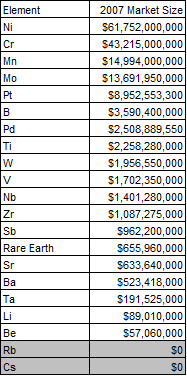
You can see that the concept is simple. Commodities, like metals, are fungible, so just take the tonnage produced, an average annual price, and multiply it out. The above data has Rubidium and Cesium at zero because the markets were so small way back in 2007 that we simply couldn't get an estimate. Notice also that we excluded big items like base metals.
I have been doing this for years, and it helps me work out what to pay attention to.
Which bits of the Critical Minerals Economy actually matter?
I am posing that headline as a loaded question.
In the days of national security, they all matter, a lot, because there are lists, and whitepapers, and strategy documents, and policies, and sanctions, and consultants.
I am a humble theoretical physicist who stumbled into the financial market as a way to earn a crust when the last Cold War ended, funding dried up, and there were no movies to celebrate folks like J. Robert Oppenheimer, while failing to make any mention of Sir Mark Oliphant.
Since I did not go to business school, am not an economist, have zero interest in politics, and know too much about weapons systems development to get excited by nuclear submarines, the whole approach I take to critical minerals is plumb hick simple:
Show me the money. Can't show me no money, then don't show me that mineral.
I will admit this viewpoint is harsh, but life is too short to analyze 46 minerals.
National security wonks can go have hernias, and apoplexy, in the pike position.
Let them. The USA spends well more than $800B USD per year on their military. If they need some funky mineral in a market worth less $50M then let them go out and get it themselves.
If you don't know how to mine minerals, or process them, then just be nice to somebody who does. Pay them money. Get minerals.
Eat won tons. Write them a check. Go home with the mineral in your cabin baggage.
Global Gross Minerals Product (GMP)
Let us cut to the chase on how I, at Jevons Global, invest in commodities. Remember that line about "show me the money" - that is how. If the market is tiny, I do not care.
Life is too short to worry about whether we run out of Cesium (Cs) or Rubidium (Rb).
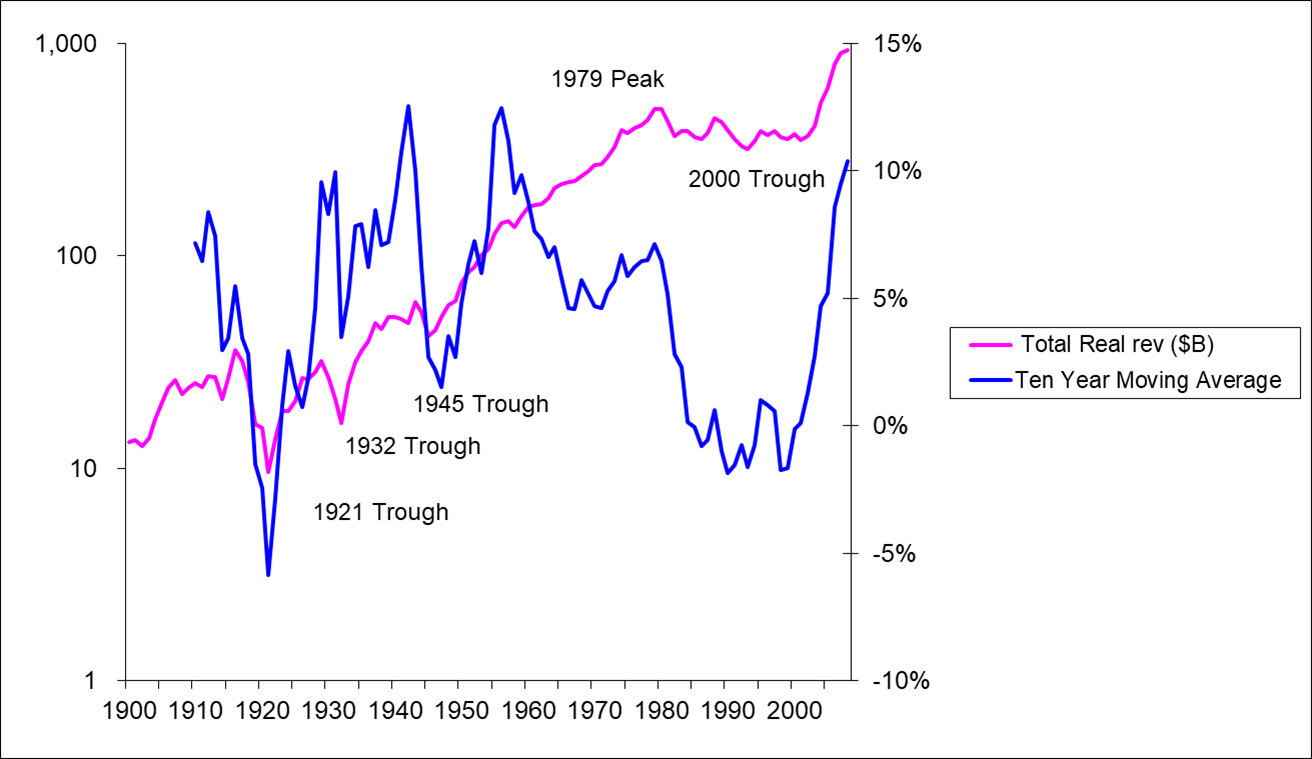
At my firm, we run estimates of Gross Mineral Product (GMP) for each commodity on which we can obtain the data, and also in aggregate, to produce the world total. When this number is suitably deflated, we can look at the real value of the commodities produced.
This idea is so simple that no economist appears to have thought of it.
The numbers can be revealing. For instance, the period from 1979 to 2000 was one very long global depression for the commodities industry. I first constructed this chart way back in the period 2003-2004 when the China boom was just starting.
In those days, the Australian financial market thought that mining stocks were bad investments. Once you analyzed the commodity economy correctly, you realized something else.
Iron ore was such a great business that the majors remained profitable during a two-decade long depression for their industry.
The firm that I then worked for bought BHP Group ASX: BHP and RIO Ltd ASX: RIO, plus the now delisted zinc producer Zinifex. Our fund did very well.
Iron ore is still a good business today, but the China growth pulse has passed.
In the industry jargon, iron ore is ex-growth, and miners should manage for cash-flow.
That is not all bad, which is why we like Fenix Resources ASX: FEX.
Let's now look at the composition of the Gross Mineral Product by commodity.
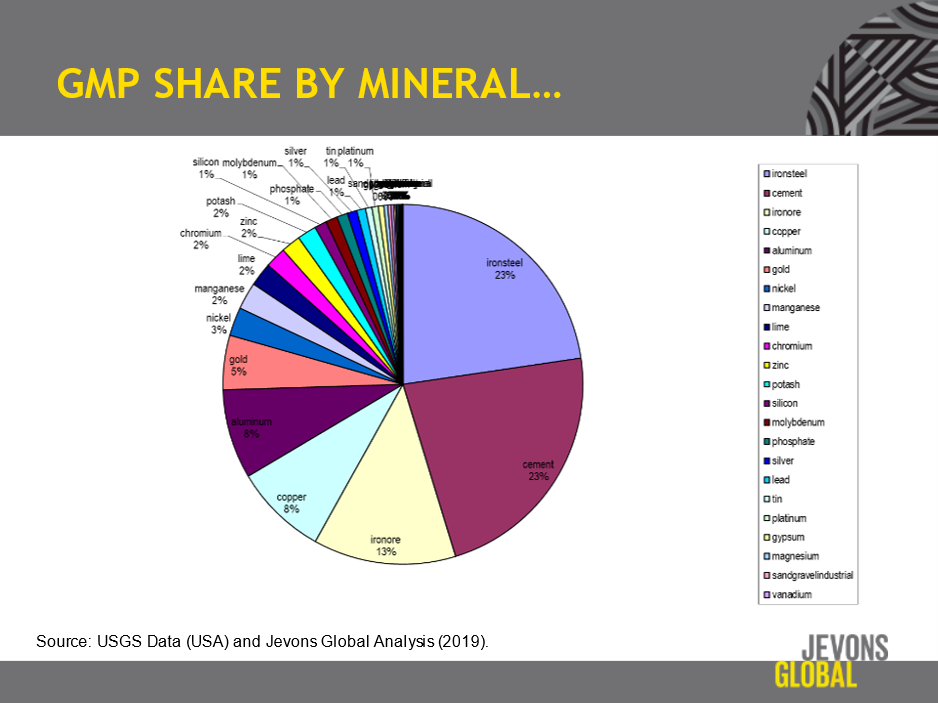
Source: USGS Data (USA) and Jevons Global Analysis (2019).
This is from a few years ago. I did this on purpose as Lithium (Li) does not show up at this level of the pie chart. It is there, along with many other critical minerals, but was too small.
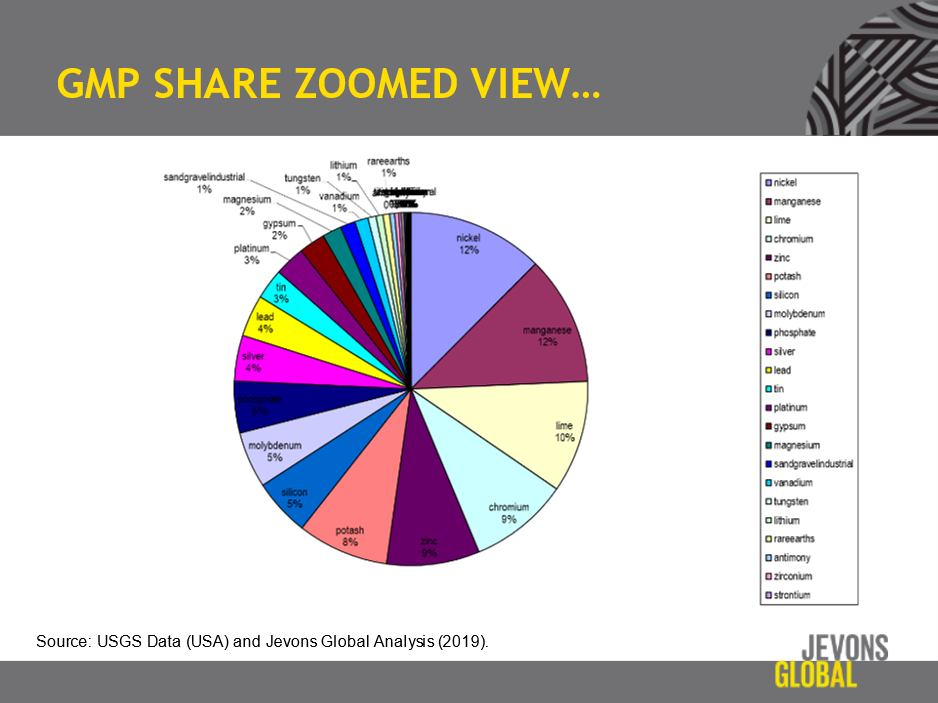
Source: USGS Data (USA) and Jevons Global Analysis (2019).
We can get a better perspective on the size of the critical minerals economy by basing our pie chart at Nickel (Ni), as the big dog, by ignoring everything bigger than that.
Lithium (Li) shows up now, at 1% of that smaller pie. It is bigger now, but you can appreciate the commonsense of my unique approach to commodity investing.
Most funds managers focus on commodity price, I focus on the commodity economy.
However, for most of the metals that the hype cycle has worshipped the Nickel based view of the world is still too gross. You really need to zoom the microscope a lot more.
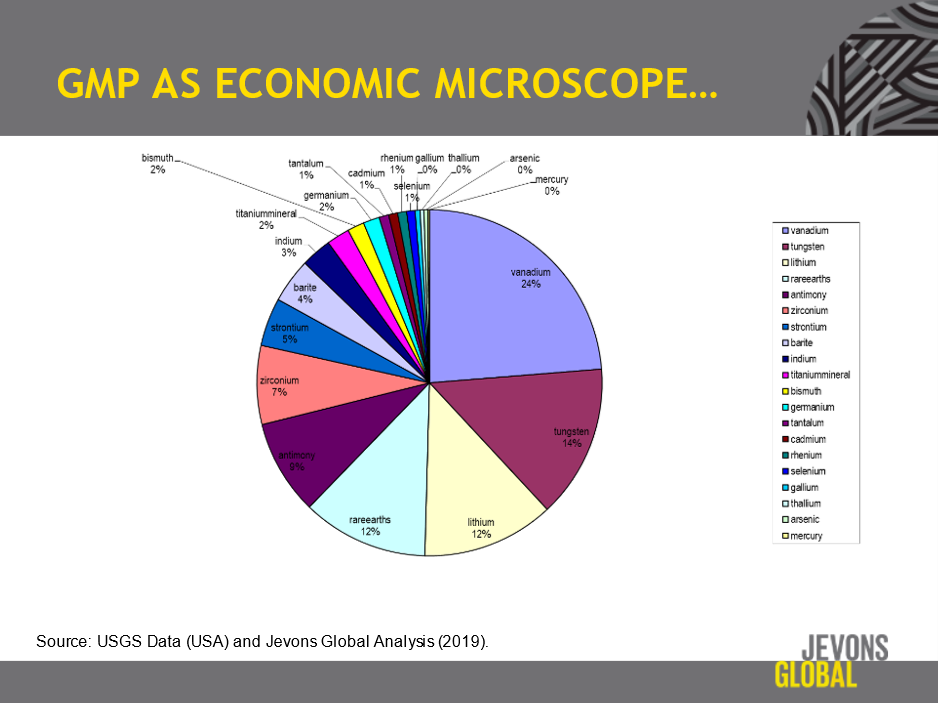
Source: USGS Data (USA) and Jevons Global Analysis (2019).
This time I chose Vanadium (V) as the base measure. You can see that we are getting places now, with Tungsten (W) and Lithium (Li) and Rare Earths (REE) appearing.
Recall this is from 2019. The updated data is a bit different from that.
I am not showing it here because I am busy augmenting the analysis with trade data so as to better understand the geopolitics of who is a producer and who is a consumer.
I don't need to tell you that there is an awful lot of squawking going on. I am not going to show you that analysis today, but flag that some who squawk a lot don't buy much.
This leads me to a refinement of the "show me the money" principle:
If you are a nation that squawks a lot, but does not buy very much, then party with Arsenic (As) or Mercury (Hg) because this puppy ain't listening and won't be investing.
That seems harsh, I know, but it is the way of the world.
Mining is hard enough as it is without wasting your life talking to politicians.
Conclusion
The Lassonde cycle is clearly with us in Rare Earths, while Lithium remains strong for quality exploration and development projects. Recognize that many commentators on the critical minerals space do not have any economic interest in the outcome.
I consider my audience to be the investment community.
Critical minerals are an excellent space to specialize in, but one must understand that there is a brutal economic logic in play.
Small markets command little attention from capital.
Sustained development of this industry requires an investment fraternity that is committed to achieve good outcomes, beyond the current hype cycle. The think tanks will be gone just as soon as the public interest level dies. However, that is when mines need to close funding, or the mines and processing plants won't get built.
The better and more detailed the public understanding of the economics of critical minerals the more likely we are to put nationalist fears to bed, and successfully grow our industry. Otherwise, the coming capital drought may kill it.
While the concept of Gross Mineral Product (GMP) has served me well as an investor for over twenty years, I am now making it public to help frame sound policy.
3 topics
3 stocks mentioned
